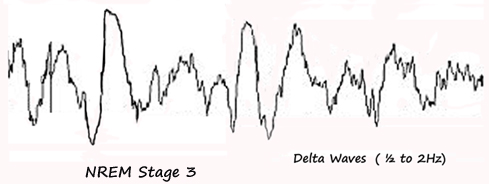How Sleep Works
A Guided Tour
Stage 2: Steady, Light Sleep
The muscles throughout your body continue to relax. The slow, rolling movements your eyes made as you were falling asleep have stopped, and they now remain still. Your heart-rate and breathing are nice and regular. Your body temperature continues to drop and your metabolism slows.
You are now completely and unambiguously asleep. You’ve just entered stage 2 of NREM — a steady, solid sleep but still relatively light. Stage 2 makes up the biggest part of the sleep cycle. By morning, you will have spent altogether about half the night here.
Take another look at your brain waves: You see that the theta waves which appeared minutes ago in stage 1 continue to predominate, but a couple of new waveforms have shown up. They’re called sleep spindles and K-complexes. Both of them come repeatedly in short, one or two second bursts and together they are the hallmark of stage 2. Sleep spindles are quick pulses of high-frequency wave activity. They make a pattern said to look like a spindle on an old-fashioned spinning wheel (a reference that’s pretty much lost on most people today). K-complexes come in large, jagged, high-amplitude blips leaving a sort of K-shaped slant. The two patterns may have something to do with the way the brain filters out sensory information in order to suppress arousal and maintain sleep.

By this time, your consciousness has long since faded away. You are no longer aware of your surroundings, nor are you even aware of your own existence. The constant stream of thoughts, perceptions, and feelings that form the essence of mind and experience have vanished. Scientists are only beginning to understand how and why this happens — indeed, nobody really even understands just what consciousness is — but the latest research gives us some important clues.
You have to think of the brain, not as one single entity, but as a network of smaller brain regions with specialized tasks, all talking to each other and interacting as they retrieve and process information (this is sometimes likened to the way vast millions of computers link together to form the internet). It’s all this networking and interaction between the brain regions that some scientists think generates the phenomenon we experience as consciousness. And, in fact, experiments show that during sleep this network seems to turn itself off. The various regions of the brain go offline one by one; they continue to function, but they sort of compartmentalize and stop talking to each other. The brain is still “On” but it’s working in a completely different way.
It’s been about 15 to 20 minutes now since you first fell asleep. You’ve been snoozing along pretty good in a relatively light but unbroken sleep. But now you’re about to leave stage 2, sinking even deeper into the third and deepest stage of Non-REM sleep.
Stage 3: Deep Sleep
As you enter stage 3, we see that your brain waves are changing once again. The theta waves, sleep spindles, and K-complexes can still just be seen. But a series of large, slow, looping waves called delta waves start to dominate the picture. These are low-frequency, high-amplitude waves in the .5 to 2 Hz range, and their lazy, slow-moving pattern has given stage 3 the name “slow-wave sleep.” Not long into stage 3, the delta waves will crowd out the theta waves altogether and there will be only the faintest hints of sleep spindles and K-complexes.

The muscles throughout your body are deeply relaxed now and your eyes remain still. Your blood pressure has dropped further, and your breathing and heart rate are slow and regular. Your brain too has slowed down, mostly in the regions having to do with your emotions and social interaction. Scientists speculate about what this means: Do certain parts of the brain need to shut down and “reboot” in order to maintain mood and emotional balance?
Stage 3 is where much of the restoration of the body takes place — all the healing and new growth that keeps your body humming along. Growth hormones are released to spur the generation of new cells. This is particularly true in males where you’ll see a whopping two-thirds of all growth hormone production occur in the third stage of the very first sleep cycle. Testosterone is also replenished during deep sleep; in young men, testosterone production starts as soon as you fall asleep and reaches its daily high point towards the end of your first sleep cycle.
Once you enter adulthood and stop growing, the need for growth hormone is naturally reduced quite a bit. In fact, if you’re in your middle years, you’ll produce less than half as much growth hormone in deep sleep as you did when you were young. Interestingly, you’ll also spend less of your total sleep time in stage 3 — an association we’ll explore further a little later on.
Stage 3 predominates in the first hours of a night’s sleep, coming in progressively shorter periods as the night goes on. The first episode of stage 3 usually lasts 30 to 40 minutes. Altogether, stage 3 accounts for about 20 to 25% of a night’s sleep. Since this is the deepest sleep in the cycle, it is the hardest to wake up from.
You’ve been out for over an hour at this point, and you’ve reached the deepest part of the sleep cycle. But now your night’s sleep is about to take an abrupt turn: You are about to slip into REM.
